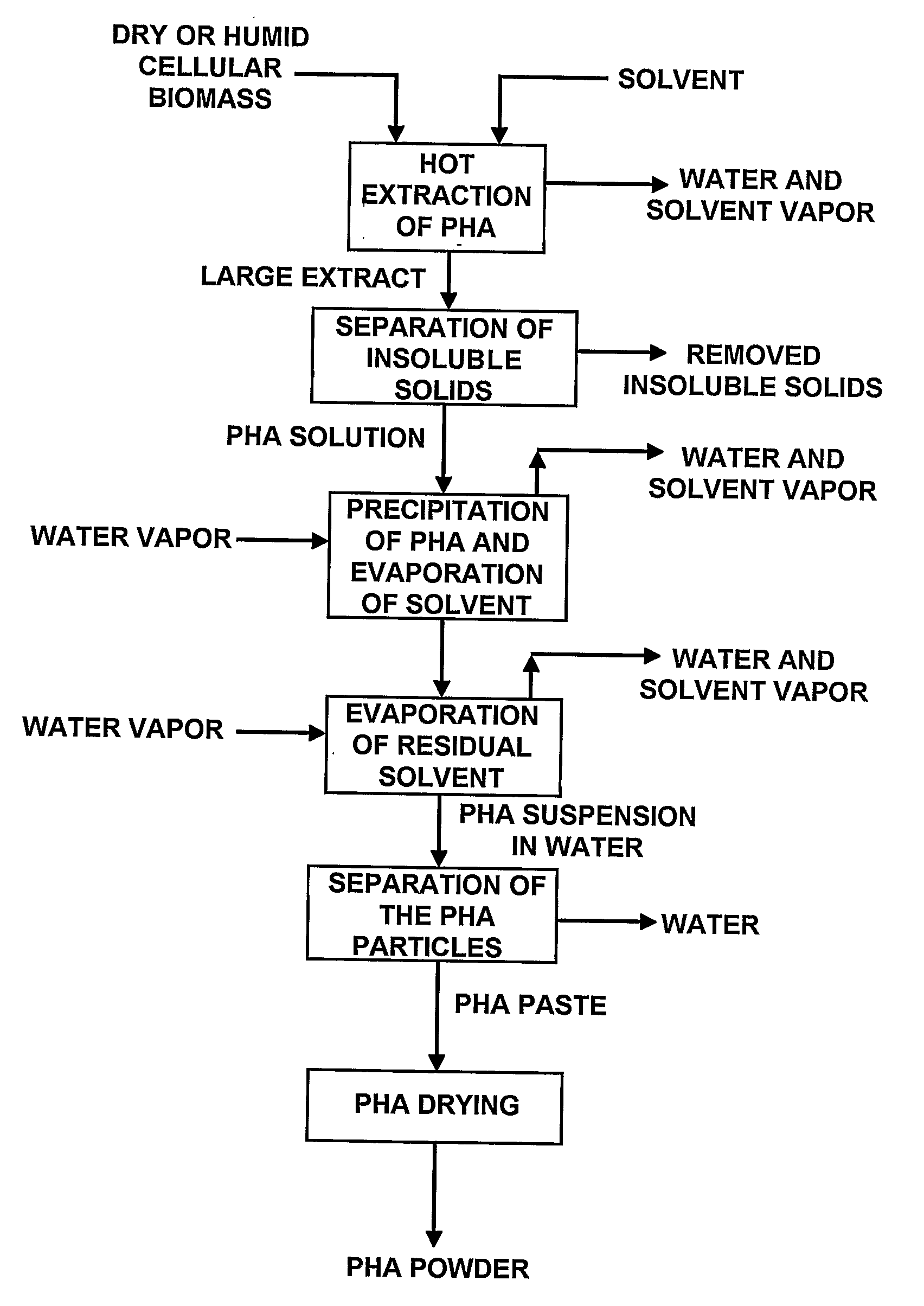Process for Extracting and Recovering Polyhydroxyalkanoates (Phas) From Cellular Biomass
a technology of bacterial cellular biomass and polyhydroxyalkanoate, which is applied in the direction of fertilization, etc., can solve the problems of large amount of effluent generated in the process, high cost of enzymes, and increasing environmental problems
- Summary
- Abstract
- Description
- Claims
- Application Information
AI Technical Summary
Benefits of technology
Problems solved by technology
Method used
Image
Examples
example 1
PHB Extraction and Recovery Using Isoamyl Propionate as Solvent
[0095]To a 500 mL round bottom distillation flask, 50 g of concentrated biomass of Alcaligenes eutrophus, containing 78.4% dry material and 58.8% PHB with molecular weight of 1,000,000 Da, and 300 g of isoamyl propionate were added. The suspension was then submitted, under agitation, to evaporation of a fraction of solvent and water, by using a heating blanket coupled to the distillation flask. The thus generated binary vapor was conducted to a straight tube condenser (Liebig type) for condensation and the resulting condensate was collected in an Erlenmeyer recipient. The suspension was maintained in an evaporation process under agitation until reaching the extraction temperature. The temperature was read in a mercury thermometer affixed to one of the flask nozzles and maintained in contact with the vapor phase inside the flask. The extraction temperature was reached after an evaporation time of about 3 minutes had ela...
example 2
PHB Extraction and Recovery Using Propyl Butyrate as Solvent
[0096]To a 500 mL round bottom distillation flask, 50 g of concentrated biomass of Alcaligenes eutrophus, containing 78.4% dry material and 58.8% PHB with molecular weight of 1,000,000 Da, and 300 g of propyl butyrate were added. The suspension was then submitted, under agitation, to evaporation of a fraction of the solvent and water, by using a heating blanket coupled to the distillation flask. The thus generated binary vapor was conducted to a straight tube condenser (Liebig type) for condensation and the resulting condensate was collected in an Erlenmeyer recipient. The suspension was maintained in an evaporation process under agitation until reaching the extraction temperature. The temperature was read in a mercury thermometer affixed to one of the flask nozzles and maintained in contact with the vapor phase inside the flask. The extraction temperature was reached after an evaporation time of about 3 minutes had elaps...
example 3
PHB Extraction and Recovery from Dry Biomass Using Isoamyl Valerate as Solvent
[0097]To a 500 mL round bottom distillation flask, 50 g of concentrated biomass of Alcaligenes eutrophus, containing 78.4% dry material and 58.8% PHB with molecular weight of 1,000,000 Da, and 300 g of isoamyl valerate were added. The suspension was then submitted, under agitation, to evaporation of the solvent and water, by using a heating blanket coupled to the distillation flask. The thus generated binary vapor was conducted to a straight tube condenser (Liebig type) for condensation and the resulting condensate was collected in an Erlenmeyer recipient. The suspension was maintained in an evaporation process under agitation until reaching the extraction temperature. The temperature was read in a mercury thermometer affixed to one of the flask nozzles and maintained in contact with the vapor phase inside the flask. The extraction temperature was reached after an evaporation time of about 3 minutes had e...
PUM
| Property | Measurement | Unit |
|---|---|---|
| Temperature | aaaaa | aaaaa |
| Temperature | aaaaa | aaaaa |
| Percent by mass | aaaaa | aaaaa |
Abstract
Description
Claims
Application Information
 Login to View More
Login to View More - R&D
- Intellectual Property
- Life Sciences
- Materials
- Tech Scout
- Unparalleled Data Quality
- Higher Quality Content
- 60% Fewer Hallucinations
Browse by: Latest US Patents, China's latest patents, Technical Efficacy Thesaurus, Application Domain, Technology Topic, Popular Technical Reports.
© 2025 PatSnap. All rights reserved.Legal|Privacy policy|Modern Slavery Act Transparency Statement|Sitemap|About US| Contact US: help@patsnap.com



